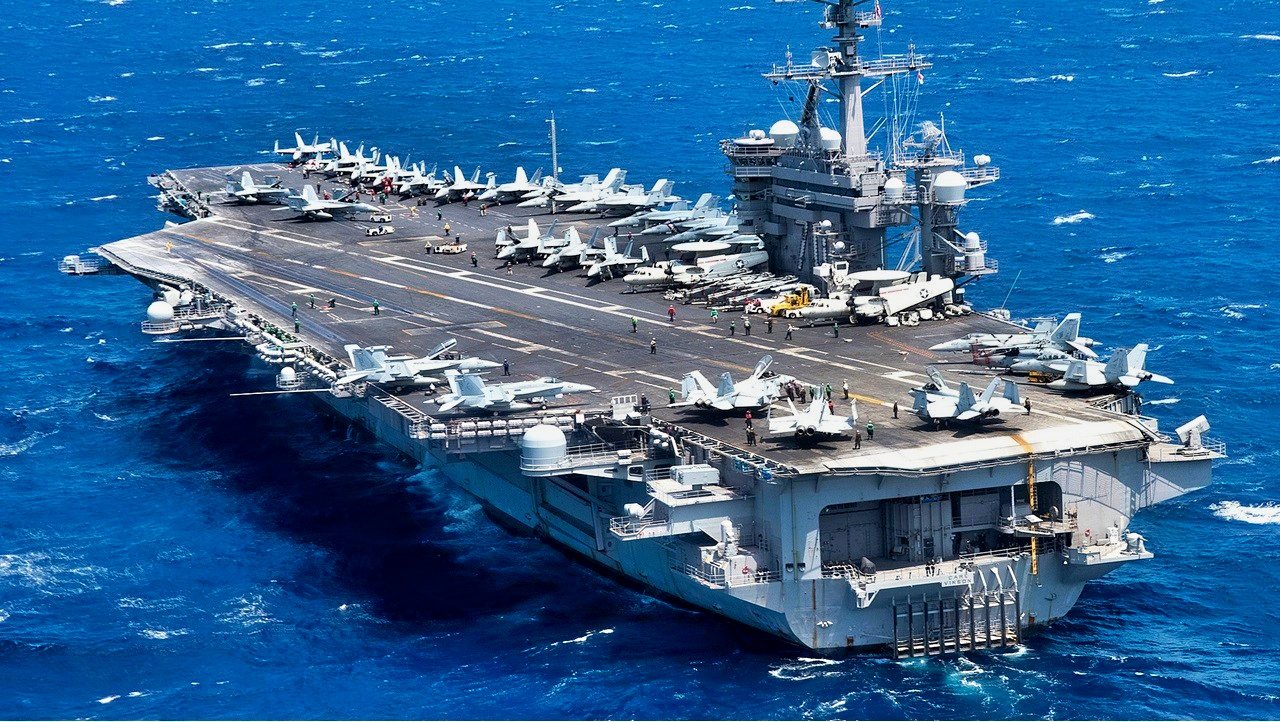USS Carl Vinson Is a Powerhouse Aircraft Carrier Like No Other
Over the years, the USS Carlon Vinson was deployed multiple times and saw service in Operations Southern Watch, Iraqi Freedom, Enduring Freedom, and in the fight against ISIS.
USS Carl Vinson Primer: Nothing says power like a nuclear-powered aircraft carrier.
Boasting a massive flight deck and multiple highly advanced combat aircraft, they are the pinnacle of modern navies. The USS Carl Vinson is no exception.
Carl Vinson: What’s in a Name?
The Carl Vinson is named after Congressman Carl Vinson of Georgia’s 10th Congressional District, which encompasses a region in Northeast Georgia, including the town of Athens.
Congressman Vinson was one of the longest-serving members of the United States House of Representatives and had an outsized influence on U.S. naval and defense policy during his tenure.
Vinson was born and raised in Georgia. He received his undergraduate education and law degree in the state from the Georgia Military College and Mercer University respectively.
He entered public life after only a few years practicing law, serving first in the Georgia House of Representatives and then as the Baldwin County court judge.
In 1914, Vinson won a special election to fill the Congressional seat in the 10th district. There, he served from November, 1914, to January, 1965.
His 26 consecutive terms over 50 years was a record that stood until 1992. After maintaining a relatively low profile through his first decade in Congress, Vinson began exerting his influence in the 1920s when he became the ranking member of the House Naval Affairs Committee. From this post, he was appointed to serve on the Morrow Board, whose recommendations helped shape military aviation in the U.S. through the Second World War. In 1931, he became the Chairman of the Naval Affairs Committee, and his work truly began.
Over the next decade, Vinson was instrumental in the passage of several laws that expanded American Naval shipbuilding and power. This work culminated in the Two Ocean Navy Act, a massive procurement that increased the size of the Navy by over 70%. Its passage in 1940 could not have come at a better time as the U.S. would be in a world war the next year, facing off against German U-boats in the North Atlantic and Japanese carrier fleets in the Pacific.
In the decades following WWII, Vinson served as Chairman of the newly minted House Armed Services Committee for 20 nearly uninterrupted years. In this role, he saw the acquisition of the first nuclear power aircraft carrier, the USS Enterprise. For his continual championing of the Navy, the third Nimitz-class carrier was chosen to bear his name. This honor was compounded by the fact that he was still alive when it was announced. This ship has served well for 41 years.

An Aircraft Carrier Like No Other
The USS Carl Vinson is a Nimitz-class supercarrier, the second generation of nuclear-powered supercarriers fielded by the U.S. Navy.
Its design incorporates features of the Enterprise, the first nuclear-powered carrier, as well as the Forrestal-class, a conventionally powered supercarrier that preceded the Nimitz.
One of the critical design changes was the reduction of its nuclear reactors from eight to two. Despite having only a quarter of the number of reactors of the Enterprise, the Vinson puts out more power. The reduction in reactors freed up space below deck, the Vinson holds 90% more fuel and 50% more ordnance than the preceding Forrestal-class. Its design was influenced in part by the events of the era.
During the Vietnam War, carriers had served as staging areas from which to launch sorties against the enemy. As such, less emphasis was placed on their engagement against another navy and more on their ability to quickly and efficiently get strike packages airborne.

While the Vinson primarily shares characteristics with the first two ships in her class, the Nimitz, and the Eisenhower, she has gone through several refits to improve her working and living conditions, including one in 2001 in which her flight deck and catapults were completely overhauled.
As with other Nimitz-class warships, she is primarily an attack carrier, but refits and upgrades have allowed her and her air wing to participate in Anti-Submarine Warfare as well.
USS Carl Vinson: Service History
Since her commissioning in March of 1982, the Vinson has been around the world - literally.
Her numerous deployments have taken her to ports across the globe. Her initial deployment took her from Norfolk, Virginia, through the Mediterranean and Indian Oceans to ports across Australia and East Asia before finally transiting the Pacific to her new homeport in San Francisco.
Since being stationed on the West Coast, the Vinson has primarily served in the Pacific. In a deployment in 1986 in the waning days of the Cold War, she became the first modern U.S. carrier to operate in the Barents Sea.
Over the next thirty years, the USS Carlon Vinson was deployed multiple times and saw service in Operations Southern Watch, Iraqi Freedom, Enduring Freedom, and in the fight against ISIS. Notably, after Osama Bin Laden was killed in 2011, his body was flown to the Vinson for identification, and he was buried at sea from her deck following religious rites.
Later that year, she hosted the Michigan State Spartans and the North Carolina Tar Heels to participate in the first NCAA Carrier Classic basketball game.
Currently, the Vinson - with Carrier Air Wing 2 embarked - is on yet another deployment in the Western Pacific on her mission of forward presence and deterrence.
Maya Carlin is an analyst with the Center for Security Policy and a former Anna Sobol Levy Fellow at IDC Herzliya in Israel. She has by-lines in many publications, including The National Interest, Jerusalem Post, and Times of Israel. You can follow her on Twitter: @MayaCarlin.
All images are Creative Commons.


